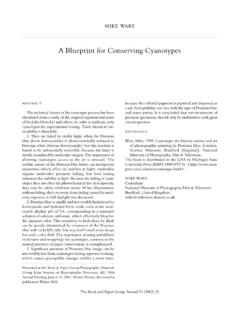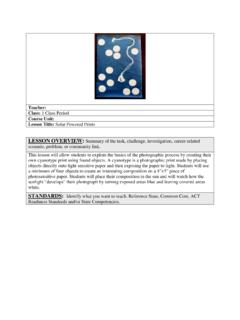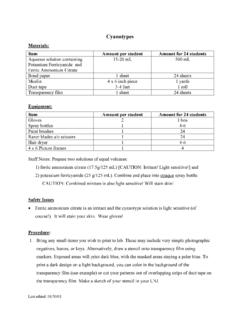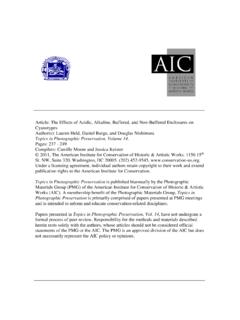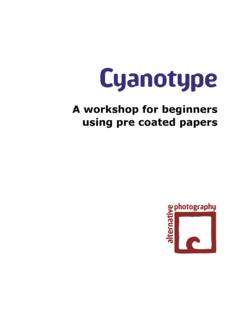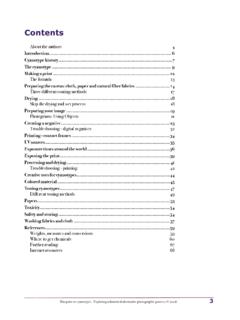Transcription of Cyanotype Toning v2 - berk-edu.com
1 Hybrid photography 1 Steven Berkowitz Cyanotype Toning THEORY : There are three types of chemicals that affect Cyanotype prints. These chemicals can be used singly. One approach is the bleach the color out of a dark print. Another is to intensify the color of a normal print. A third is to alter the tone of the pigment. And then there are a slew of combinations. Reducers act as bleaches, degrading the blue color in the print Sodium Carbonate, Borax, Ammonia, Intensifiers deepen the color of the print Hydrogen Peroxide, Lemon Juice, Citric Acid, Toners change the color of the iron in the print Tannic Acid, Oolong Tea, Wine, Cat Urine, Pyrogallic With Silver prints, a common practice is to bleach the color out of the silver and then re-develop the print in either Sepia or another Developer.
2 This same technique can be preformed by combining a bleaching step with a toner step. The most common combo for Cyanotype is Sodium Carbonate and Tannic Acid. Many of these recipes can be used in either direction, or repeatedly back and forth, each time producing a different tone. And each time you print, different tones may result. Changes can be very subtle to very extreme. It is possible to render cyanotypes dark blue to chocolate brown or even black with many shades in between. Experimentation and careful note taking are important to be able to produce consistent results.
3 MATERIALS: The Toning of cyanotypes can happen at home just as easily as in a lab. The materials can all be purchased at your local supermarket and can be poured safely down the drain when done. If you prefer stronger or more official chemicals, all the ingredients can be purchased from photographic chemical supply houses, most notably: Photographer s Formulary Bostick & Sullivan Reducers supermarket : Laundry Detergent with active ingredient Sodium Carbonate, Borax Laundry Detergent, White Ammonia, photo chemical supply: Print Developer Intensifiers deepen the color of the print supermarket: Hydrogen Peroxide, Lemon Juice, Vinegar photo chemical supply.
4 Citric Acid Toners change the color of the iron in the print supermarket: Oolong Tea, Wine, (Cat Urine (behind the market?)) photo chemical supply: Tannic Acid, Pyrogallic Acid photo chemical supply: PRACTICE : General Considerations: Overexpose prints to be toned by at least one stop (until the highlights are gray). warning: highlights lost during reduction can never be regained! Prints should cure at least one day after printing before Toning . Soak the prints in distilled water before you start Toning . Do a final wash for 10 ~ 15 minutes in running water at the end.
5 Replace the chemicals as soon as they start to get dark (10 ~ 15 prints per tray). Always rinse between chemicals to increase toner life by about 5 prints per tray. Always add chemicals to water, never the other way around. hybrid photography 2 Steven Berkowitz Cyanotype Toning BASIC RECIPES : BLEACHING ONLY produces a subtle yellow/blue split, [reduction] SODIUM CARBONATE OR LAUNDRY DETERGENT Sometimes, just bleaching a print can produce a good result. This is a common practice with silver prints. It works better if the print is at least one stop darker than normal.
6 Mix a bleaching solution of Sodium Carbonate Washing Powder (1 TB per quart of WARM water) immerse the print for 2 seconds to 30 seconds pull the print quickly from the Bleach and watch the split tone happen in the air over the tray if you wait for it to look right in the chemical tray, it will be over-bleached by the time you get it out rinse for 15 minutes in running water produces a subtle yellow/blue split, warning: longer goes more yellow but only if the image doesn't disappear first! note: Borax Landry Detergent can also be used, with a slightly different effect warning: Clorox household bleach can remove Cyanotype completely INTENSIFIER for CONTRAST CONTROL [intensification] LEMON JUICE OR VINEGAR Acid will intensify the density of the Prussian Blue.
7 Citric or Acetic acids will work fine and are commonly available products, lemon juice, orange juice or vinegar (stinky). add oz. Lemon Juice or Vinegar (supermarket variety) to 1 qt of water to make a small tray of Intensifier vary the dilution for more or less effect bathe prints for 30 seconds only wash in plain running water for 15 minutes re-mix this solution often as it is becomes exhausted quickly OXIDIZER for FINAL TONALITY [intensification] HYDROGEN PEROXIDE Prints will not reach their full density until they are dry (usually overnight).
8 This is because it takes time for the Sensitizer to oxidize in the air. It is possible to force an immediate oxidation of the prints by rinsing for about 1 minute in a bath of dilute Hydrogen Peroxide. This brings prints to their full intensity. While not necessary, this will provide immediate gratification . add 1 2 TB Hydrogen Peroxide (drugstore variety) to 1 qt of water to make a small tray of Oxidizer immerse the print for 1 minute wash for 15 minutes Hydrogen Peroxide Oxidation can be used as the final step in all Toning processes mentioned below.
9 Hybrid photography 3 Steven Berkowitz Cyanotype Toning TEA Toning [toner] BLACK TEA OR TANNIC ACID Where Tea Toning with silver prints is a dying effect, the tannic acid in tea actually has a chemical reaction with the iron in the Cyanotype to cause a change in color. The tannic acid in the tea reacts with the ferric ferricyanide (iron) to produce ferric tannate that is very archival. A short immersion in tannic acid will reduce the edge of the Prussian blue color to a navy blue. Longer processing will take the print into the brown range and finally to an almost black color.
10 After a while the tea will stain the paper itself. This produces a warm-tone base, not unlike some of the warm-tone papers used for regular silver printing. This tone combines well with the darker and warmer color of the Cyanotype . Immerse the print in a strong tea, preferably an inexpensive black tea. Tannic Acid powder can also be used, as well as the Cyanotype Toning Kit Solution B from Bostick & Sullivan. It is best to make up a small batch of strong tea every other print or so. Then make another strong batch for the next two prints, and so on.


